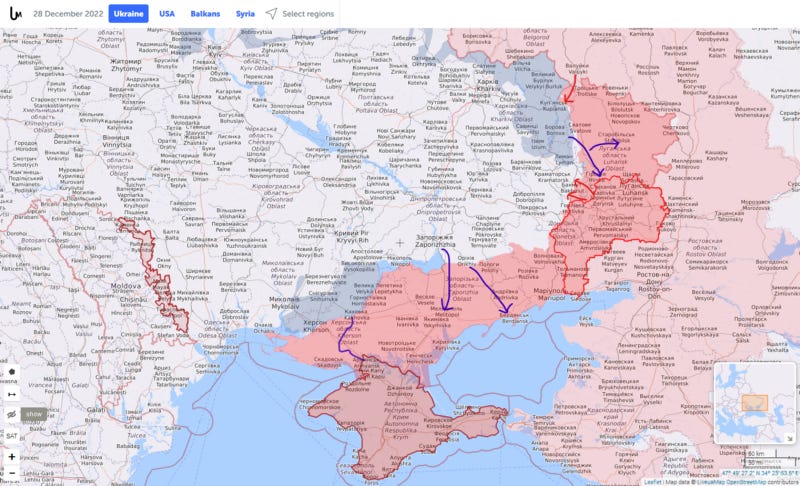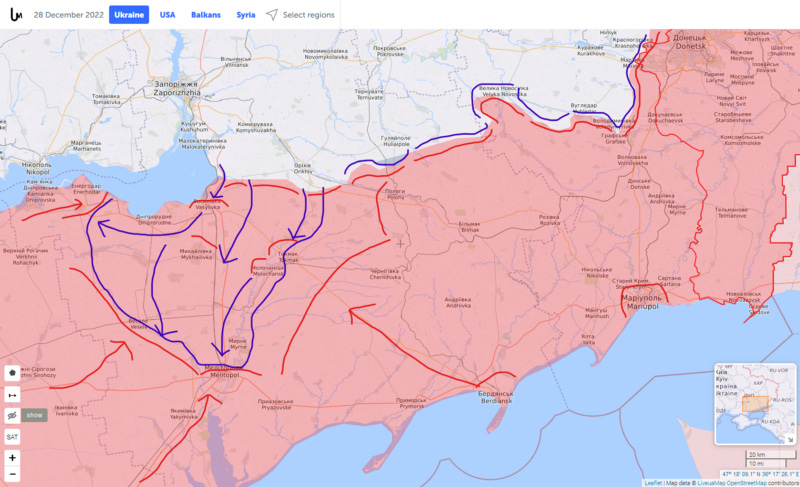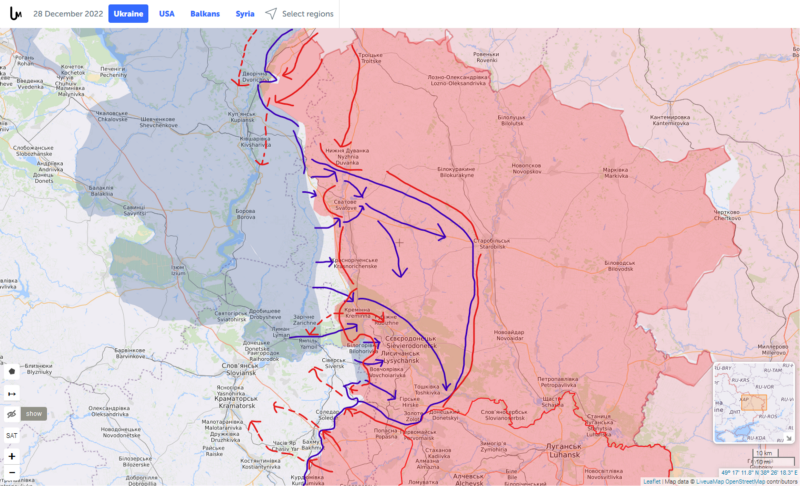Where Will Ukraine Counterattack Next?
Putin’s war to destroy Ukraine is far from over, and will probably escalate even more in the coming months than it already has.
NOTE: Originally published on Medium, December 28, 2022.

Despite successful counteroffensives in Kharkiv and Kherson, Russia’s horrific neo-imperialist invasion of Ukraine continues. Both sides are clearly preparing new campaigns, and winter will see a dramatic uptick in the intensity of the fighting.
Most Western military analysts working with the media have been hard at work selling the Biden Administration’s preferred take on the conflict so far. Having reverted to a kind of wartime mentality where questioning the team or its leadership is tantamount to treason, most American commentators fail to even attempt unbiased evaluations of the fighting and the future of the conflict.
It is worth remembering that back in World War Two, American journalists actively protected the President of the day, FDR, from public scrutiny. Most people didn’t even realize the man was largely confined to a wheelchair thanks to a bout with polio because of the media-enabled pageantry that surrounded his public appearances.
In American public life, nobody wants to risk their access to insider sources in the administration or foreclose the possibility of future employment. As a result, most journalists, writers, and pundits take care to keep their predictions within certain bounds defined not by empirical evidence, but by what powerful people prefer Americans believe about the world abroad.
This is why most assumed Kyiv would fall in a matter of days, following predictions released by Pentagon insiders who were using inadequately vetted computer models. And when Ukraine didn’t collapse, its armed forces and volunteers obeying Zelensky’s order to inflict maximum casualties, they were left looking like fools. None then or today want to admit that Putin’s invasion could have been deterred and was as motivated in terms of timing by the Biden Administration debacle in Afghanistan as any other single factor.
Now, this does not mean that Russia isn’t solely responsible for this war, its leaders deserving of imprisonment in the Hague or worse. Moscow’s actions have placed Putin in the company of Hitler from any reasonable perspective, and he must pay the price for all he has wrought, the tens of thousands who have died because of his ridiculous beliefs about history.
But if you want to come to a scientific understanding of why a thing happened in order to prevent a future repeat, it is essential to map out all factors. As someone with both scientific and military scout training, I cannot take any approach but a deliberately systematic one.
And this warns that far from on its last legs, the Russian Army is preparing for another, potentially even more vicious assault. Likely, this will be one that follows basic military logic and seeks to open a new front where Ukraine might not be adequately prepared or overwhelms its forces along the front lines in Donbas.
Thanks to enacting partial mobilization in September and its deep reserves of military gear, Russia is capable of regenerating much of its combat power and has been working hard to do so for three months now. While committing a portion of its new forces to holding the line in Donbas and keeping pressure on Ukraine around Bakhmut, between a third to a half are undergoing intensive training in Russia and Belarus in preparation for their first combat deployments.
This is a big part of why Zelensky recently visited Washington to speak to American leaders in DC. To defeat Russia’s new offensive and maintain its own efforts to liberate stolen territory, Ukraine needs a guaranteed supply of new weapons and ammunition into the new year. Ideally these will include more modern gear like Leopard tanks, Bradley infantry fighting vehicles, and F-18 or F-16 fighter jets, but at the least Ukraine has to know that at least the current levels of support will be maintained through summer.
Ukraine needs better military gear to reduce its casualties and leverage technology to offset Russia’s growing advantage in numbers. It has performed a miracle so far in protecting Ukraine in large part because Russian forces were not ready for any kind of extended fight. Western supplies of anti-tank and anti-aircraft weapons still dwarf Ukraine’s pre-existing stocks of Soviet era material, and it was primarily the delivery of long-range artillery and rocket systems that represented a real game-changer in terms of Western aid.
Ukraine’s defense forces have been wisely putting new personnel through intensive training with what new equipment its partners abroad have donated so far before committing them to the fight. This means that Ukraine is likely able to maintain the number of troops it has in the field for a long time, replacing battered formations with fresh and better equipped ones. But it does not mean that Ukraine has a large reserve available sufficient to both combat new Russian attacks and carry out its own counteroffensives.
This could be established if Ukraine’s partners would truly open their arsenals, setting aside Putin’s nuclear bluffs as they must to avoid him making them forever. However, the Biden Administration and perhaps the leaders of France and Germany as well have accepted Putin’s alleged Red Lines over delivery of tanks, combat jets, and long-range missiles.
So Ukraine is forced to be extremely judicious with its deployment of new forces, limiting its counteroffensives to geographically favorable sectors where Russian forces were over-extended and at risk of being cut off. This may change given that strategic factors like the continued assumption of large-scale US financial support are now in doubt thanks to the Republicans taking control of the House.
Zooming out to look at the global picture, after nearly a year into the fighting Western sanctions have not brought down the Russian economy nor has anyone made a move to unseat Putin. It is becoming absolutely clear that Biden, Macron, Scholz, and other Western leaders fear Putin’s fall more than they do a long-term stalemate. They appear to have convinced themselves that Putin will eventually see reason once he suffers enough and return to negotiations.
This is, sadly, wishful thinking. Putin’s rhetorical commitments to the fighting have only intensified, and escalation to the nuclear threshold remains a very real possibility despite the Biden Administration’s non-credible threats to directly intervene in the fighting if Putin drops the bomb. Putin’s rhetoric has backed his regime into a corner, and he cannot end the war without bringing all annexed regions of Ukraine under his control.
Yet Ukraine’s people and leaders will not accept anything less than full liberation of all territories occupied after 2014. This is, frankly speaking, entirely reasonable given the brutality of Russia’s assault and Putin’s lies about his true intentions in Ukraine from the get-go. The inviolability of established international borders is one of the principles that must be maintained or all hope of global cooperation, let alone peace, is destroyed forever.
Yes, the USA has done more than its share to degrade this essential norm — never forget that Biden voted to let Bush invade Iraq. America’s time will come, and it will pay the price for its many misdeeds. But Russia’s crimes in Ukraine are too heinous to wait for the judgment of history, and his territorial aggression cannot be tolerated, lest it inspire other leaders to follow suit and plunge the whole world into an era of endless conflict.
And whatever anyone feels about the morality or ethics of the situation, the simple fact remains that the world is now in a situation where a nuclear power is claiming itself to be under open and perhaps even existential attack by a nuclear-armed alliance engaged in a proxy war. The most likely outcomes are as follows:
1. Ukraine wins on the battlefield, forcing Putin to either go nuclear or retreat, the latter almost certainly leading to his swift fall so disregarded as an option by the would-be Tsar in Moscow.
2. Russia finally overwhelms Ukraine’s resistance after foreign aid dries up and forces Kyiv to seek peace at any cost, including territorial concessions that cause Ukraine to fracture.
3. A bitter grinding stalemate that drives both sides to exhaustion and, eventually, at least indirect negotiations. Then in five or ten years this all happens again, but worse.
Option three is what the Biden Administration is clearly after, because option one opens the door to a true third world war while option two would represent open defeat, and he like Putin would rather we all go down with him than admit he’s lost. Three only kicks the can down the road a ways, but this is the basic strategy all the world’s power brokers have relied on for decades and an old hand at this game like Biden can’t change his stripes now that he’s an octogenarian.
In truth, Biden is merely a cipher for rich east coast types who are so up to their neck in the rank American mythos about its postwar self they can’t see the USA is on the brink of total collapse. But any change from the status quo is the same as death for them, so they don’t care if their inept, self-serving ways damn the rest of us to a bleak future they won’t be alive to deal with.
But Ukraine is going to do its absolute damnedest to make Option 1 a reality in 2023, and assuming that Russia’s new offensive is defeated or never gets off the ground, the winter freeze will trigger a new round of Ukrainian attacks. Where they fall is a question lots of folks have been asking since September, when it appeared Ukraine’s momentum might carry it much further than proved the case, likely because its backers were terrified of what that would mean.
Most of fall Russia has been faking an interest in open negotiations while Biden has been subtly pressing Kyiv to enter into talks too. This has allowed Russia time to regain its footing and pursue its demolition of Ukrainian power, heating, and water infrastructure, with Western supplied air defenses like the Patriot coming far too late to help with the immediate crisis.
Ukraine has been preparing for the next round, needing the ground to freeze hard to allow its largely wheeled forces greater ability to maneuver. Winter will be relatively harder on the less-prepared Russian forces in Ukraine, particularly those not able to shelter in villages, meaning that Ukraine could find or generate a gap in the Russian defenses somewhere large enough to slam a major attack force deep into the rear.
I hesitate to suggest that Ukraine would go this route, however, because Russia has been preparing layered defenses all over the front line in an attempt to make any frontal assault prohibitively costly. Yet it may be that Ukraine has no choice, because waiting for Russia’s next attack to fall and be defeated before pushing a counterstroke cedes much of the battlefield initiative to Putin’s field commanders.
Ukraine might continue relying on pinprick strikes against vulnerable Russian air and naval facilities, but as much as these embarrass Moscow they don’t substantially change the balance of power on the ground. Sooner or later Kyiv will have to push to liberate stolen lands despite the cost to soldiers who should have long ago been equipped with the full spectrum of high-tech NATO gear.
So where might Ukraine hit Putin’s orcs next? I see three main options, two of them perhaps less likely than the one I’d myself choose at this stage because of how much press they have received.
The first and most obvious option for Ukraine is one I’ve written about several times over the past six months, and that’s a strike towards Melitopol in Zaporizhzhia district. If successful, this would sever the ground link to Crimea Putin needs to defend the peninsula now that the Kerch Strait Bridge is down a couple lanes.

Problem is, Russia’s withdrawal from Kherson allowed it to dramatically reinforce this region. And one of the laws of modern warfare is that advancing through open country like the steppes of southern Ukraine is very, very hard in a world of drones and artillery, especially when there’s little foliage on the trees to create cover. To mass the required forces to break through would tip Ukraine’s hand, making surprise difficult to achieve.
So it might be more reasonable to expect Ukraine to strike in Luhansk province, where Kreminna is already under threat and the northern flank of the forces assaulting Bakhmut potentially vulnerable to a sudden strike. Ukraine has been grinding forward in this sector for weeks, and to stop the advance Russia is apparently having to pump in reserves.

Trouble with this sector is its proximity to Russian territory serviced by dense logistics networks. There is a reason Ukraine isn’t advancing further east in Luhansk and is presently defending Kupiansk: Russia has built up a large force in the area that threatens to hit Ukrainian forces going after Kreminna from the north. Ukraine’s difficulties here aren’t getting much press, but Russia is also now attacking towards Lyman, meaning a breakthrough towards Sievierodonetsk is going to be tough.
There are other parts of the front where Ukraine could attempt a surprise attack, but unfortunately most would involve taking on Russian defenses in the area that have been around for eight years. The Moscow-backed “separatists” in the region would be defending urban areas, and so far Ukraine has tried not to seize these by force. And as gratifying as it would be to see Ukrainian tanks rolling towards Moscow, this just isn’t possible given Russia’s nuclear arsenal.
The Russian military may rebel if Putin goes nuclear and it then fears an open war with NATO is imminent. It won’t if Ukraine is pushing deep into Russia proper, as justified as that might be.
This might make Ukraine’s prospects for pushing back Putin’s forces seem bleak, yet recent Russian moves to fortify other parts of the Azov coast indicate Moscow is concerned Ukraine wants to strike further east than Mariupol. And this could pose a serious problem for Russia, because its forces could be having serious trouble actually holding the 200km front line between the Dnipro and the occupied city of Donetsk.
After feinting towards Melitopol, a Ukrainian attack force several brigades strong could penetrate the first Russian defense lines north of Tokmak then turn east, joining another force in hitting Russian forces defending Polohy. If a breakthrough is achieved, Ukrainian armored reserves could commit to a push towards Berdiansk, an important port about halfway between Mariupol and Melitopol.

Even if Ukrainian forces can only push the front line 40km towards the coast, this brings the highway linking Rostov to Crimea overland into HIMARS range and the main rail line to Melitopol from Donbas under Ukrainian fire control. Which is a clever term Kyiv has come up with to describe the situation Russian logistics convoys are in once the front line is close enough that they get blown up by artillery.
Pressing Russia like this would threaten to divide its forces defending occupied Crimea from the rest. It might even eliminate the potential for a grand Russian winter offensive by forcing Putin to commit his reserves. It would also mostly cover territory without dense urban cover Russian soldiers could use to keep warm and hidden.
The danger, of course, is that Russian counterattacks from the east and west could cut off the Ukrainian assault and inflict serious casualties. But so far Russian forces have proven unable to coordinate these kinds of actions on large scales. And once Ukrainian light infantry with portable anti-tank and anti-aircraft weapons flood an area, good luck rooting them out!
It is worth pointing out for what feels like the hundredth time that this war can only end if Ukraine’s battlefield victories break the Russian army’s ability to fight. That is the scenario that leads to Putin attempting nuclear escalation then either failing or falling to a coup.
Which, crazy as it sounds, is the best hope the world has for getting through this war in one piece. Because history shows that maniacs like Putin don’t give up or give in, not when they go this far. And no amount of DC wishful thinking pumped out by think tanks whose experts long ago should have realized their theories were inadequate and found a new paradigm can alter this awful truth.
A nuclear confrontation is coming. And the only way out is through.
May the gods grant Ukraine the victory it so manifestly deserves in 2023!



